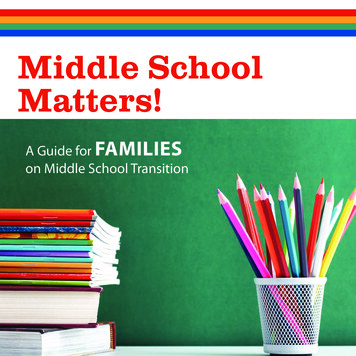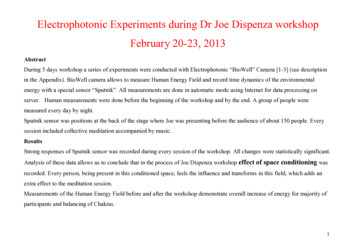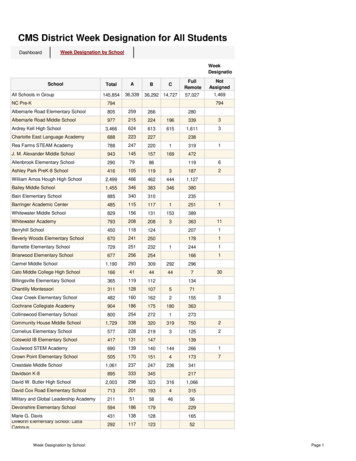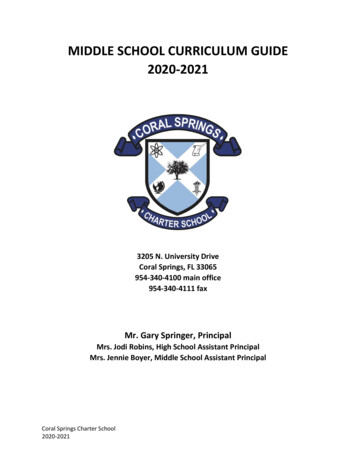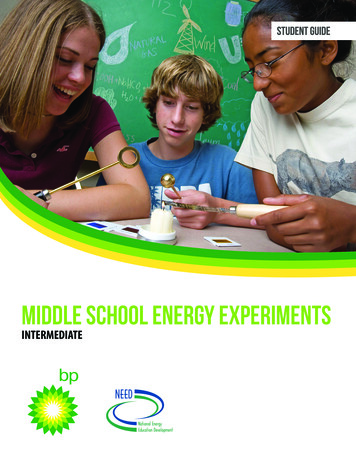
Transcription
MIDDLE SCHOOL ENERGY EXPERIMENTSINTERMEDIATE
Fueling the nextgeneration of innovatorsScience, technology, engineering, and math (STEM) affect nearly every aspect of our lives —from the cars we drive, to the food we eat, to the smartphones we use to communicate.Innovation is the key to helping the U.S. stay competitive in today’s globalized, technologydriven world. As a result, STEM jobs are in high demand and typically pay significantly betterthan non-STEM fields. To fill the high-skilled jobs that will power the American economy in thefuture, the U.S. needs more students to study STEM.Additionally, BP depends on people with strong foundations in STEM to help solve the world’senergy challenges. These engineers, scientists, and other professionals find ways to produceand deliver the energy that heats our homes, powers our schools, cooks our food, and fuels ourcars. The information and activities in this booklet will help you understand the important roleSTEM plays in the energy industry.2 2015 The NEED Project8408 Kao Circle, Manassas, VA 201101.800.875.5029www.NEED.org
Table of Contents 2015 The NEED ProjectStudent Text4Clean Air6Corroding Metals7Cryogenic Roses8Energy from Garbage9Cooling Fan10Heavy Backpacks11Insulation12Natural and Man-Made Fibers13Natural Herbicide14Natural Plastic15Saving Hot Water16Seeds and Needs17Solar Distillation18Waste Heat19Wind Around Your Home20Biodegradability21Insulating with Air22Absorbing Solar Energy238408 Kao Circle, Manassas, VA 201101.800.875.5029www.NEED.org3
eIntroduction to EnergyWhat Is Energy?Energy makes change; it does things for us. It moves cars along theroad and boats over the water. It bakes a cake in the oven and keepsice frozen in the freezer. It plays our favorite songs and lights ourhomes. Energy makes our bodies grow and allows our minds to think.Scientists define energy as the ability to do work.Forms of EnergyKINETICPOTENTIALChemicalEnergyForms of EnergyEnergy is found in different forms, such as light, heat, sound, andmotion. There are many forms of energy, but they can all be put intotwo categories: potential and POTENTIAL ENERGYPotential energy is stored energy and the energy of position, orgravitational potential energy. There are several forms of potentialenergy.NuclearEnergy Chemical energy is energy stored in the bonds of atoms andmolecules. It is the energy that holds these particles together.Biomass, petroleum, natural gas, propane, and the foods we eat areexamples of stored chemical energy.MotionEnergyGravitationalPotentialEnergy Elastic energy is energy stored in objects by the application of aforce. Compressed springs and stretched rubber bands are examplesof elastic energy. Nuclear energy is energy stored in the nucleus of an atom; it is theenergy that holds the nucleus together. The energy can be releasedwhen the nuclei are combined or split apart. Nuclear power plantssplit the nuclei of uranium atoms in a process called fission. The suncombines the nuclei of hydrogen atoms in a process called fusion. Gravitational potential energy is the energy of position or place.A rock resting at the top of a hill contains gravitational potentialenergy because of its position. Hydropower, such as water in areservoir behind a dam, is an example of gravitational potentialenergy.KINETIC ENERGYKinetic energy is motion; it is the motion of waves, electrons, atoms,molecules, substances, and objects. Electrical energy is the movement of electrons. Everything is madeof tiny particles called atoms. Atoms are made of even smallerparticles called electrons, protons, and neutrons. Applying a forcecan make some of the electrons move. Electrons moving through awire are called electricity. Lightning is another example of electricalenergy.ThermalEnergySoundEnergy Thermal energy, or heat, is the internal energy in substances;it is the vibration and movement of the atoms and moleculeswithin a substance. The more thermal energy in a substance, thefaster the atoms and molecules vibrate and move. Geothermalenergy is an example of thermal energy. Motion energy is the movement of objects and substancesfrom one place to another. Objects and substances move whenan unbalanced force is applied according to Newton’s Laws ofMotion. Wind is an example of motion energy. Sound energy is the movement of energy through substances inlongitudinal (compression/rarefaction) waves. Sound is producedwhen a force causes an object or substance to vibrate; the energyis transferred through the substance in a longitudinal wave. Radiant energy is electromagnetic energy that travels in vertical(transverse) waves. Radiant energy includes visible light, x-rays,gamma rays, and radio waves. Solar energy is an example of radiantenergy.4 2015 The NEED Project8408 Kao Circle, Manassas, VA 201101.800.875.5029www.NEED.org
Conservation of EnergyYour parents may tell you to conserve energy. “Turn off the lights,”they say. To scientists, energy conservation is not just about savingenergy. The Law of Conservation of Energy says that energy isneither created nor destroyed. When we use energy, it doesn’tdisappear. We change one form of energy into another.A car engine burns gasoline, converting the chemical energy ingasoline into motion energy. Solar cells change radiant energy intoelectrical energy. Energy changes form, but the total amount ofenergy in the universe stays the same.Energy ChemicalElectricalThermalEfficiencyEnergy efficiency is the amount of useful energy you get from asystem. A perfect, energy efficient machine would change all theenergy put in it into useful work—a technological impossibilitytoday. Converting one form of energy into another form alwaysinvolves a loss of usable energy.Most energy transformations are not very efficient. The human body is agood example of this. Your body is like a machine, and the fuel for yourmachine is food. Food gives you the energy to move, breathe, and think.Your body isn’t very efficient at converting food into useful work.Most of the energy in your body is transformed and released asthermal energy (heat). You can really feel that heat when youexercise! This is very much like most energy transfers. The loss ofuseable energy is often in the form of thermal energy (heat).Sources of EnergyWe use many different energy sources to do work for us. They areclassified into two groups—renewable and nonrenewable.In the United States, most of our energy comes from nonrenewableenergy sources. Coal, natural gas, petroleum, propane, and uraniumare nonrenewable energy sources. They are used to make electricity,heat our homes, move our cars, and manufacture all kinds ofproducts. These energy sources are called nonrenewable becausetheir supplies are limited. Petroleum, a fossil fuel, for example,was formed hundreds of millions of years ago from the remainsof ancient sea plants and animals. We can’t make more crude oildeposits in a short time.Renewable energy sources include biomass, geothermal energy,hydropower, solar energy, and wind energy. They are calledrenewable because they are replenished in a short time. Day afterday, the sun shines, the wind blows, and the rivers flow. We userenewable energy sources mainly to make electricity.U.S. Energy Consumption by Source, 2013NONRENEWABLE, 90.5%Petroleum35.2%Biomass4.7%Natural 3%Geothermal0.2%Uses: transportation,manufacturingUses: electricity, heating,manufacturingUses: electricity, manufacturingUraniumUses: electricityPropaneElectricity is different from the other energy sources because it isa secondary source of energy. We must use another energy sourceto produce electricity. In the U.S., coal is the number one energysource used for generating electricity.Uses: electricity, heating,transportationUses: electricityUses: electricityUses: electricity, heating1.7%Uses: heating, manufacturingElectricityRENEWABLE, 9.4%Uses: electricity, heatingData: Energy Information Administration*Total does not equal 100% due to independent rounding.Electricity is sometimes called an energy carrier because it is anefficient and safe way to move energy from one place to another,and it can be used for so many tasks. As we use more technology,the demand for electricity grows. 2015 The NEED Project8408 Kao Circle, Manassas, VA 201101.800.875.5029www.NEED.org5
Clean AirGrade Levels: 4-6& BackgroundMore than 60% of a school’s energy bill is spent on heating, cooling, and ventilating buildings to keep the air safe to breath and the righttemperature.? QuestionDoes indoor or outdoor air have more particles? Possible Hypothesisair has more particles. Materials 14 White index cards Petroleum jelly Cotton swabs Tape Magnifying glassProcedure1. Label the index cards I-1 to I-7 and O-1 to O-7. (I is for “Inside” and O is for “Outside”.)2. Smear petroleum jelly on cards I-1 and O-1 using a cotton swab and tape them to the same window: I-1 on the inside and O-1 on theoutside. Close the window. Avoid placing the cards near a door.3. After 24 hours, take the cards down and repeat the procedurewith the cards labeled I-2 and O-2. Make a note of the weathereach day, and what you see happening to the petroleum jelly.4. Do this for a week, replacing the cards each day. Examine thecards closely and compare them to each other and to previoussets.5. Record your observations, noting any differences.6. Repeat the experiment in a different location or at a differenttime of year. Analysis and ConclusionHow does the air inside and outside compare? How does itcompare in different weather, different locations, and in differentseasons? How clean would you say the air is in your neighborhood?6 2015 The NEED Project8408 Kao Circle, Manassas, VA 201101.800.875.5029www.NEED.org
Corroding MetalsGrade Levels: 4-9& BackgroundEverything has energy. You eat food because its chemical energy gives you energy to run and talk and play. Chemical energy is also storedwithin the tiny particles, called atoms, within a material. Those atoms are held together in a bond. If a bond is broken or created, chemicalenergy is transferred in something called a chemical reaction. Sometimes when materials mix together, chemical reactions occur, andenergy is released.A Vocabulary corrosion: a slow breakdown of a metal? QuestionsWhat types of metal are susceptible to corrosion?What kinds of liquid promote corrosion? Possible Hypothesiswill / will not corrode when exposed to . Materials Bowls Water Orange juice 2 Pieces of steel wool 2 Stainless steel teaspoons 2 Pennies 2 Squares of aluminum foilProcedure1.Fill two bowls – one with water and the other with juice.2.Put one piece of each of the metal objects in each bowl.3.Leave the metals in the liquids for a week where they will not be disturbed.4.After one week, take out the metal samples and examine them. Record yourobservations. Analysis and ConclusionWhich liquid caused more corrosion? Which metals were more susceptible tocorrosion? Was there a combination of liquid and metal that caused the mostcorrosion? When can you use metals that corrode and when should you usemetals that don’t corrode? 2015 The NEED Project8408 Kao Circle, Manassas, VA 201101.800.875.5029www.NEED.org7
Cryogenic RosesGrade Levels: 4-9&BackgroundWhen living things die, they slowly break down or decay over time. This is a chemical reaction where chemical energy is transferred.Adding heat or removing heat can cause a chemical reaction to speed up, or slow down. Heating or cooling a material can also changehow quickly its energy is released or absorbed.A Vocabulary cryogenic: a material at a very low termperature? QuestionCan ice be used to preserve once-living things? Possible HypothesisIce can/cannot preserve once-living things. Materials 5 Rose buds just beginning to open 4 Plastic bowls Water Freezer Procedure1.Fill four plastic bowls with equal amounts of water.2.Observe the five rose buds and record any differences in the fragrance, texture, appearance, or color.3.Submerge one rose bud in each bowl of water and put the bowls in the freezer, keeping one rose bud at room temperature for acontrol. Observe the control daily and record your observations.4.After one week, allow one rose bud to thaw and observe, comparing it to the control and to the observations made before freezing.Place the thawed rose bud with the control.5.Repeat this procedure the next week with another frozen rose. Do this weekly until all roses have been thawed and observed. Analysis and ConclusionDid ice preserve the roses well? Did the length of freezing have an effect? What happened to the roses once they were thawed? How didthe freezing affect the decaying process? Real World ConnectionWhat practical applications could this technique be used for?8 2015 The NEED Project8408 Kao Circle, Manassas, VA 201101.800.875.5029www.NEED.org
Energy from GarbageGrade Levels: 4-6&BackgroundThe average person in the United States creates about four pounds of trash every day! This includes materials like aluminum, plastic, paper,and food and yard waste. Some of these materials break down at the landfill. Have you ever driven by a landfill? Why do you think it smells?Decaying garbage creates an odor because a gas is being created as the trash decays. You can’t see the gas, but you can smell it! That trash,even when it’s decaying, contains energy!? QuestionsCan you produce a gas from decaying garbage?Can you control the amount of gas produced from decaying garbage? Possible HypothesesA gas is/is not produced when garbage decays.The amount of gas from decaying garbage can/cannot be controlled. Materials Packet of dried beans or peas 6 Airtight clear plastic bags Water Procedure1.Soak the beans or peas in water overnight.2.Place 10 beans or peas into each bag and squeeze out all the air before you seal them.3.Put two bags in a warm, sunny place, two bags in a warm, shady place, and two bags in a totally dark place for a week and observewhat happens. Record your observations. Analysis and ConclusionDid the decaying beans produce a gas? Which environment was best for producing gas? Do you think the gas could be used as a source ofenergy? Why and how?Sunny 2015 The NEED Project8408 Kao Circle, Manassas, VA 20110Shady1.800.875.5029www.NEED.org9
Cooling FanGrade Levels: 4-6& BackgroundOver half of the energy that we use in our house is used for heating and for cooling. In the summer, some people suggest that you turn on afan instead of your air conditioner (or raise the temperature of your air conditioner and use a fan) as a way to save energy and save money.? QuestionDoes a fan really cool the air? Possible HypothesisA fan does/does not cool the air. Materials Portable fan Thermometer Procedure1.On a hot day, place a portable fan on a table. Use a thermometer to record the temperature in the room.2.Turn the fan on and hold the thermometer three feet from it, so that the air blows on the thermometer. After one minute, record thetemperature.3.Hold the thermometer two feet from the fan. Record the temperature after one minute.4.Repeat Step 3 with the thermometer one foot away. Analysis and ConclusionAt what distance was the temperature the coolest? What locations might be best for putting fans in your home? Explain using observationsand data from your experiments.10 2015 The NEED Project8408 Kao Circle, Manassas, VA 201101.800.875.5029www.NEED.org
Heavy BackpacksGrade Levels: 4-6& BackgroundDoctors say it isn’t healthy for students to carry more than ten percent of their weight in their backpacks. It requires energy to lift the booksoff of the ground.? QuestionAre the students in your school carrying too much weight in their backpacks? Possible HypothesisStudents are/are not carrying too much weight in their backpacks. Materials Weight scaleProcedure1.Make a chart with the names of all the students in your class, as shown.2.Weigh all of the students in your class and calculate ten percent of their weight. Record this on the chart.3.Weigh all of the student backpacks before they go home every day for a week. Record the weights on the chart.4.Circle the backpacks that are overweight. Analysis and ConclusionHow many students in the class carry overweight backpacks? Is it a major problem? Talk to your classmates and teacher about ways toremedy the problem.Weight of BackpacksStudent NameWeight10% 2128599910 Real World ConnectionWhat if you have to carry extra books? How can you reduce the amount of energy required to lift your books? 2015 The NEED Project8408 Kao Circle, Manassas, VA 201101.800.875.5029www.NEED.org11
InsulationGrade Levels: 4-6& BackgroundOver half of the energy that we use in our houses is used for heating and for cooling. We can keep the warm or cool air inside by insulatingour homes. Saving energy can also save families money on their energy bills.? QuestionWhich materials make good insulators? Possible HypothesesFoam is a good/poor insulator.Cloth is a good/poor insulator.Paper is a good/poor insulator. Materials 2 Shoeboxes Scissors 2 Thermometers 1 Piece of Styrofoam about one inch thick Newspaper Towel Black construction paper Tape Sun or lampProcedure1.Tape black construction paper to the outside bottoms of the shoeboxes.2.Place the box tops in a sunny place with the thermometers inside facing up. Record the temperatures.3.Invert one box onto a top so the black bottom istoward the sun or lamp. This is your control.4.Tape a piece of Styrofoam to the inside of thebottom of the second box, and then place itupside down over the second top.5.Record the temperatures of both boxes after 15minutes.6.Remove the Styrofoam and tape thick pieces ofnewspaper in the bottom of the box. Repeat theprocedure and record the temperatures.7.Remove the newspaper and tape a towel into thebottom of the box. Repeat the procedure andrecord the temperatures. Analysis and ConclusionWhich material was the best insulator? What other substances might make good insulators?12 2015 The NEED Project8408 Kao Circle, Manassas, VA 201101.800.875.5029www.NEED.org
Natural and Man-Made FibersGrade Levels: 4-9& BackgroundOur clothes are made out of different materials. “Natural” fibers and fabrics come from plants or animals. For example, cotton is a plant, andsilk comes from the cocoons of silkworms. Some fabrics are called “man-made” or “synthetic” because man produces them from chemicals.For example, polyester is made from a petroleum product. Even our fashion choices are related to energy!A Vocabulary deteriorate; to become worse, break apart, to decay decompose; to rot, to separate into original elements? QuestionDo natural fibers decompose faster than man-made fibers? Possible HypothesisNatural fibers will decompose faster/slower than man-made fibers. Materials Old 100% cotton t-shirt (natural) Old nylon stocking or tights (synthetic) Old wool sock or yarn (natural) Old acrylic or polyester sweater (synthetic) Plot of soil Water Glass jar with lidProcedure1.Cut three four-inch squares from each material.2.Bury one square of each material, making sure you mark the spot where they are buried.3.Put squares of each material in a jar, fill it with water, and put a lid on it. Place the jar inside in a sunny place.4.Place the third set of squares in a dark place where they will not be disturbed.5.After one month, remove the samples from the ground, the dark place, and the jar. Examine the squares and record your observations. Analysis and ConclusionWhich fibers deteriorated? Which environment made thematerials deteriorate more quickly? Can you find out why? 2015 The NEED Project8408 Kao Circle, Manassas, VA 201101.800.875.5029www.NEED.org13
Natural HerbicideGrade Levels: 4-6& BackgroundHerbicides, or more often, pesticides, are chemicals that are used to kill unwanted plant life, like weeds. All plants, including weeds, useenergy from the sun to grow. A process called photosynthesis allows them to turn the light from the sun into sugar for food. Using aherbicide stops a plant from being able to make the food it needs to continue growing and gathering light from the sun.? QuestionCan you make a natural herbicide? Possible Hypothesiscan be used as a natural herbicide. Materials 20 Leaves from a black walnut tree 4-quart Pot and stove Draining spoon Water Procedure1.Put the leaves in the pot and fill it half-full with water. Have an adult boil the mixture on the stove for 10 minutes.2.Remove the leaves using the draining spoon and boil the rest of the mixture for 20 minutes. This liquid is the herbicide for testing.3.Locate weeds around your home. Each day at dusk pour about two ounces of the herbicide on half of the weeds and the same amountof water on the other half of the weeds. These will be the control weeds.4.Do this for seven days, recording your observations each day. Analysis and ConclusionDid the natural herbicide work? Do research on the black walnut tree to discover its properties. Do you think using natural herbicides is agood idea? Do you think the leaves of other trees would work, too?14 2015 The NEED Project8408 Kao Circle, Manassas, VA 201101.800.875.5029www.NEED.org
Natural PlasticGrade Levels: 4-6& BackgroundPlastics are materials that we use every day. You probably can look around the room and point to several items that have plastic in them oron them. Many of the plastics we use today are made from petroleum, or oil we drill from the earth. Making plastics uses energy. Plasticsare useful because they can be very strong. Do plastics decompose as quickly as natural materials? QuestionsCan you make your own natural plastic?Does natural plastic decompose better than petroleum-based plastic? Possible Hypothesisplastic decomposes better than plastic. Materials 2 Glass jars 4 ounces (120 ml) Whole milk Teaspoon of vinegar Pot and stove Plastic spoon Waxed paper Plot of soil1.Pour the milk into the pot and boil it until itseparates into soft masses called curds andclear liquid. Slowly pour the liquid into oneglass jar and spoon the curds into the other.2.Add the vinegar to the curds and allow themixture to sit for two hours. The mixture willturn into a solid yellowish mass. Pour off anyliquid.3.Knead the mass into a dough, mold it intoa spoon and place it on waxed paper to dryovernight.4.Compare your spoon to the plastic spoon.Record your observations.5.Bury both spoons in a plot of soil. After twoweeks, dig up the spoons and observe anydifference.MilkProcedure Analysis and ConclusionHow did the plastics compare to each other before and after burial? Do some research on the cost to make natural plastic compared topetroleum-based plastic. What are some pros and cons to using natural plastic? 2015 The NEED Project8408 Kao Circle, Manassas, VA 201101.800.875.5029www.NEED.org15
Saving Hot WaterGrade Levels: 4-6& BackgroundAlmost 20% of the energy we use in our houses is used to heat water. If we can save water when we shower or take a bath, we are alsosaving the energy that it takes to heat the water.? QuestionDoes it save more water to take a shower or a bath? Possible HypothesisIt takes water to take a shower than a bath. Materials Bathtub with a shower Ruler Thermometer Procedure1.Have each member of your family plug the drain when taking a shower for one week.2.Measure the amount of water they used with your ruler. Write down how high the water was for each person in your family each timethey showered for a week.3.The next week, have each person take a bath instead of a shower. Use your ruler to measure how much water they use for their bath.(Make sure the person isn’t in the tub! That will change your measurements!)4.During the showers and baths, also have your family take the temperature of the water. Analysis and ConclusionCompare the amount of water used for baths and showers for eachmember of your family. Which saved more water and energy: a showeror a bath? Which member of your family used the least amount ofwater? Who is using the most energy to heat the water? Real World ConnectionLow-flow showerheads use less water than regular showerheads,but it feels like a regular shower. Does your family have low-flowshowerheads? You may want to put them into your shower and tryyour experiment again? Did they really use less water? Also, try takingcolder showers for a month. Do you notice a change in your utility bill?16 2015 The NEED Project8408 Kao Circle, Manassas, VA 201101.800.875.5029www.NEED.org
Seeds and NeedsGrade Levels: 4-6& BackgroundPlants need energy from the sun, water, and oxygen to grow. Which of these items is the most useful? QuestionsWill seeds grow faster with more water?Will seeds grow faster with more sunlight? Possible HypothesisSeeds will/will not grow with more . Materials Packet of bean seeds Water Tablespoon 20 Snack-size zip-lock bagsProcedure1.Label ten bags from 1 to 10. Label the other ten bags 1-S to 10-S.2.Place two seeds in each bag.3.Add one tablespoon of water to bags 1 and 1-S, two tablespoons of water in bags 2 and 2-S, and so on until all the bags have water.4.Place the bags in a sunny place. Leave the bags marked with an S in the sun all the time. Leave the other bags in the sun for two hoursa day.5.Compare the beans in the bags after one week. Record your observations. Analysis and ConclusionWhat effect did the amount of water have on seed growth? What effect did the amount of sunlight have on seed growth? Do you thinkthe seeds would grow better if they were in sunlight 24 hours a day? 2015 The NEED Project8408 Kao Circle, Manassas, VA 201101.800.875.5029www.NEED.org17
Solar DistillationGrade Levels: 4-9& BackgroundHydropower is considered a renewable energy source because the water on Earth is constantly going through the water cycle because ofthe sun’s energy. Here’s another way we may be able to use the sun to make water more useful.A Vocabulary distill: to turn something into a gas (vaporization) and then back into a liquid (condensation) to purify it? QuestionsCan you distill clean water from muddy water?Can you distill clean water from salty water? Possible HypothesesYou can/cannot make clean water from muddy water.You can/cannot make clean water from salty water. Materials 2 Large plastic containers Clear plastic wrap Masking tape 2 Small rocks 2 Small glasses 2 Tablespoons of dirt 2 Tablespoons of salt Water Procedure1.Fill both plastic containers with one inch of water. Mix the dirt into thewater in one and the salt into the other.2.Place one empty glass upright into the middle of each plastic container.Make sure it remains empty.3.Cover both plastic containers tightly with plastic wrap and seal them withtape. Place a small rock in the middle of the plastic wrap, directly over eachglass but not touching it.4.Place the stills in a sunny place for two hours. Examine any water that formsin the glass. Record your observations. Analysis and ConclusionDid the stills make clean water? Real World ConnectionCan you explain how they worked? Can you imagine a situation in which knowledge could save your life? It is estimated that over 1 billionpeople worldwide drink water that is unhealthy. How could your project help them?18 2015 The NEED Project8408 Kao Circle, Manassas, VA 201101.800.875.5029www.NEED.org
Waste HeatGrade Levels: 4-6& BackgroundEnergy is never created or destroyed, it simply changes form. A light bulb uses electricity to create light that lights your home. Light bulbsuse the electricity to first create heat and then light. Some light bulbs need a lot more heat in order to glow.? QuestionsDoes a high watt bulb produce more heat than a low watt bulb?Does an incandescent bulb produce more heat than a fluorescent bulb? Possible HypothesisA bulb produces heat than a bulb. Materials Lamp Thermometer 25-watt Incandescent bulb 100-watt Incandescent bulb 2 Fluorescent bulbs that produce lumens comparable to theincandescent bulbsProcedure1.Put a 25-watt incandescent bulb in the lamp and turn it on.2.Hold the thermometer six inches above the bulb for oneminute and record the temperature. Turn off the lamp.3.Let the bulb cool, remove it, put in the 100-watt light bulb,and turn it on. Repeat Step 2.4.Repeat the procedure with the fluorescent bulbs. Analysis and ConclusionIs more heat produced when more light is produced?Which light bulbs are more energy efficient—incandescent orfluorescent? 2015 The NEED Project8408 Kao Circle, Manassas, VA 201101.800.875.5029www.NEED.org19
Wind Around Your HomeGrade Levels: 4-6& BackgroundWind is simply air in motion. Wind is created when the sun heats the Earth. Winds can be fast or slow depending on the weather in yourarea, the land features around you, and even how high off of the ground you are. Wind can be used to make electricity.? QuestionsOn which side of the house would you put a windmill?Is there more wind at higher altitudes? Possible HypothesisA windmill would be best on the side of the house because . Materials Pencils with erasers Thumbtack Thread—25 cm Paper Protractor Compass Procedure1.Draw a diagram of your home. Be sure to draw the objects around your home such as trees, shrubs, and other items that might blockthe wind. Label the north, east, west, and south sides of your home with the help of a compass. Mark sites that represent the areas youwill be testing and collecting evidence.2.Make a device to measure wind strength. Push the thumbtack into the eraser of a pencil and
gamma rays, and radio waves. Solar energy is an example of radiant energy. e Introduction to Energy Thermal energy, or heat, is the internal energy in substances; it is the vibration and movement of the atoms and molecules within a substance. The more thermal energy in a substance, the fa


